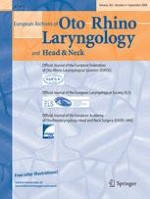01-09-2008 | Head and Neck
Salivary gland biometry in female patients with eating disorders
Published in: European Archives of Oto-Rhino-Laryngology | Issue 9/2008
Login to get accessAbstract
High-resolution greyscale ultrasound is a generally accepted diagnostic tool for salivary gland enlargement, although no standard biometrical data for the sizes of unaffected parotid and submandibular glands exist. A lot of case reports describe non-inflammatory swelling of salivary glands as symptoms of eating disorders like anorexia nervosa or bulimia nervosa. They might be the only visible sign for the disease. With our prospective study we tried to quantify and compare biometrically the salivary gland in eating disordered patients, obese and normal-weight, healthy controls. A total of 70 females between 16 and 40 years of age were included of which 25 were healthy controls. All subjects underwent three-dimensional high resolution B-scan sonography of the parotid and submandibular gland. Gland volumes were calculated and a multiple regression analysis was done to investigate the influence of an eating disorder on salivary gland size. A significant difference in the size of the parotid glands was seen between our three study groups of adipose and eating disordered patients and healthy, normal-weight controls. The parotid gland volumes were seen in the subgroup bulimia nervosa (BN), (parotid volume = 63,708 mm3) where the mean value was more than twice as high as in the control group (31,059 mm3). By using body mass index and group characteristic the parotid gland volume as the dependent variable could be estimated with an r
2 of 0.327 in multiple regression analysis. Only the parotid glands were significantly enlarged, while the submandibular glands show no signs of enlargement. Eating disorders influence size of parotid glands, still the factors and the pathogenesis leading to this enlargement seem to be different in adiposity on the one and different types of eating disorders on the other hand. Standard gland volumes could be established, comparable to former initial reports. Submandibular gland remains unaffected by these alterations. We could show that high-resolution ultrasound assessment of parotid gland volume adds a complementary quantitative parameter of organ affection in eating disorders (anorexia/bulimia nervosa).





